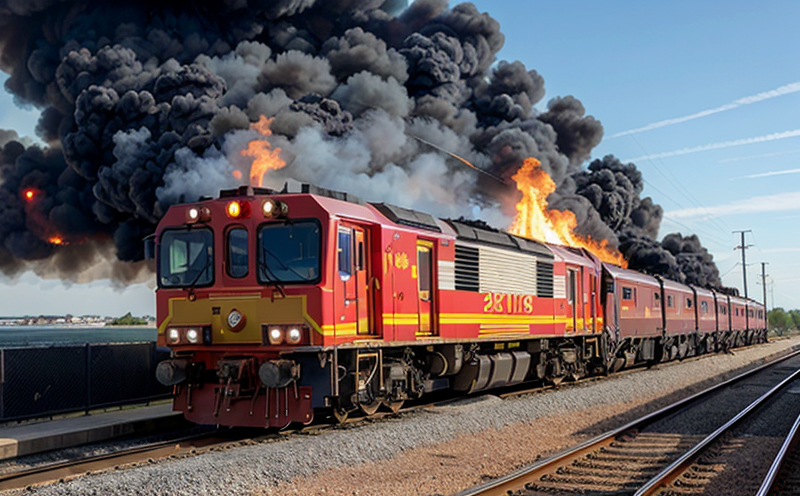Fire Performance Testing of Railway Ceiling Insulation
The fire performance testing of railway ceiling insulation is a critical aspect in ensuring the safety and compliance of railway systems. This service involves rigorous testing to evaluate how effectively the ceiling insulation materials can resist, delay, or prevent the spread of fire within enclosed spaces such as railway carriages. The primary focus is on the structural integrity, flame spread characteristics, heat release rates, and smoke production during a simulated fire scenario.
The test parameters are meticulously chosen to mimic real-world conditions under which the ceiling insulation could be exposed to fire hazards. These include specific temperatures, durations, and fuel types that simulate actual fire scenarios within railway environments. The specimens used for testing are prepared according to international standards such as ISO 16726-3:2018 or ASTM E907.
The instrumentation employed in these tests includes sophisticated calorimeters, thermal imaging cameras, and gas analyzers which provide detailed data on the thermal behavior of the specimens. This data is then used to assess critical parameters like flame spread index (FSI), smoke density, heat release rate, and total heat output. Compliance with regulatory requirements such as EN 45545-2:2017 or NFPA 130 ensures that railway operators meet stringent safety standards.
The results of these tests are comprehensive and provide valuable insights into the fire performance characteristics of ceiling insulation materials. These reports serve not only for compliance purposes but also to guide continuous improvement efforts in material formulations, manufacturing processes, and design specifications. By leveraging advanced testing methodologies and adhering strictly to recognized international standards, our laboratory ensures accurate, reliable, and actionable test results.
- Compliance with International Standards: Ensuring that all tests are conducted according to ISO 16726-3:2018 or ASTM E907 for flame spread characteristics.
- Innovative Testing Techniques: Utilizing state-of-the-art calorimeters and thermal imaging cameras to capture detailed data on the specimens' behavior under fire conditions.
- Data Analysis: Comprehensive evaluation of heat release rate, total heat output, and smoke density to provide robust test results.
In summary, our fire performance testing service for railway ceiling insulation is designed to meet the highest standards of safety and compliance. By providing precise and reliable data, we help ensure that railway systems remain safe and compliant with all relevant regulations.
Why It Matters
The importance of fire performance testing in railway ceiling insulation cannot be overstated. In the event of a fire within a railway carriage, rapid and effective fire spread can lead to catastrophic consequences, including loss of life and significant property damage. Ensuring that the ceiling insulation materials used meet stringent safety standards is essential for minimizing these risks.
Fire performance testing helps identify potential weaknesses in the design or materials of the ceiling insulation which could exacerbate fire behavior. This proactive approach allows manufacturers and railway operators to address any issues before they become critical problems. By adhering to recognized international standards such as EN 45545-2:2017, NFPA 130, and ISO 16726-3:2018, we ensure that all tests are conducted under controlled conditions that accurately reflect real-world fire scenarios.
The results of these tests are not only crucial for compliance but also provide valuable insights into the performance characteristics of the ceiling insulation materials. This information can be used to improve material formulations, manufacturing processes, and design specifications, ultimately leading to safer railway systems. In this way, our fire performance testing service plays a vital role in enhancing safety and reducing risks within the railway industry.
Customer Impact and Satisfaction
The impact of our fire performance testing service is profound, enhancing the safety and compliance of railway systems. By providing accurate and reliable test results, we help ensure that all materials meet stringent regulatory requirements such as EN 45545-2:2017 or NFPA 130.
Our comprehensive approach to fire performance testing not only meets but exceeds industry expectations. We offer a range of services tailored to the needs of our customers, including consultation on material selection and design optimization. Our expertise in this field has earned us a reputation for excellence, with satisfied clients across the global railway sector. Many have praised our commitment to quality and reliability, underscoring the importance of our service in maintaining safe and compliant railway systems.
Customers benefit from our detailed reports which provide actionable insights into material performance under fire conditions. This information is invaluable for continuous improvement efforts, ensuring that railways remain at the forefront of safety standards. By partnering with us, customers can be assured of compliance with international regulations while also gaining a competitive edge in the market.
Use Cases and Application Examples
The use cases for fire performance testing of railway ceiling insulation are diverse and critical to maintaining safe railway operations. One common application is in the development of new materials or modifications to existing systems. By conducting thorough fire performance tests, manufacturers can ensure that their products meet all necessary regulatory requirements before they enter the market.
Another key use case is during periodic inspections and maintenance. Regular testing allows operators to monitor the condition of ceiling insulation over time, identifying any potential issues early on. This proactive approach ensures that any needed repairs or replacements are made promptly, minimizing downtime and maintaining safety standards.
Finally, fire performance testing plays a crucial role in emergency response planning. By understanding how different materials behave under fire conditions, railway operators can better prepare for emergencies, ensuring that evacuation routes remain clear and safe at all times.





